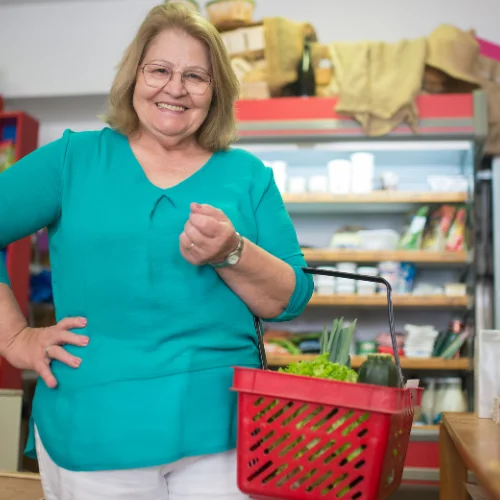Can a Person with Dementia Go Out Shopping?
If you have a loved one or know someone dealing with dementia, you might be wondering if they can enjoy a simple outing to the store. In this blog, I will discuss the possibilities and offer some tips on how to make shopping a safe and pleasant experience for someone with dementia.
What is Dementia?

First, let’s make sure we’re on the same page about what dementia is. Dementia is a brain condition that affects a person’s thinking, memory, and daily functioning. It’s more than just forgetting things; it can affect judgment, language, and even personality. Now, let’s see how this relates to shopping.
The Desire to Shop

You and I both know that shopping can bring joy and satisfaction. It’s not just about buying things; it’s also about the experience. For many people, especially those with dementia, going out to shop can be a way to feel connected to the world. It offers a sense of purpose and routine, which can be incredibly important.
Potential Challenges
However, going shopping when you or a loved one has dementia can be a bit tricky. There are a few challenges to consider:
1. Memory
Dementia affects memory, and this can be a significant obstacle when shopping. Forgetting where you’re going, what you need to buy, or even how to get back home are common challenges. It’s like trying to navigate through a maze with a foggy map.
Imagine this scenario: You’re out with your loved one who has dementia. You’ve just entered the store when they suddenly ask, “Where are we again?” This can be confusing and frustrating for both you and them.
To cope with memory issues, it’s crucial to have a clear plan. Making a list is like creating a map that can help keep your shopping trip on track. As you shop, you can refer to the list, which acts as a reminder of what you came for.
2. Confusion

Stores are bustling with activity – people rushing, shelves packed with products, and registers beeping. For someone with dementia, this environment can be overwhelming. It’s like trying to focus on a single whisper in a room filled with chatter.
Here’s how confusion might play out: Your loved one might become disoriented, not recognizing where they are within the store. The sights and sounds can make them anxious, and they may lose track of what they were looking for in the first place.
To minimize confusion, selecting less crowded shopping times, like early mornings or weekdays, can make a huge difference. Moreover, sticking to familiar stores helps create a sense of comfort and reduces the chances of getting lost in the crowd.
3. Decision-Making
Dementia can make making choices challenging. When faced with numerous options, someone with dementia might struggle to decide what to purchase. This difficulty in decision-making can lead to frustration and anxiety.
Consider this situation: You’re in the supermarket, and your loved one is staring at a shelf filled with different types of cereal. They seem paralyzed by the choices, unable to pick one. In such cases, offering just two options can be helpful.
For instance, you might say, “Would you like the one with strawberries or the one with honey?” This simplifies the decision, making it less overwhelming.
4. Safety
Safety is a top concern when a person with dementia goes shopping. There’s a risk of getting lost within the store or even outside, and the possibility of falls due to confusion or unfamiliarity with the store’s layout.
Imagine this: Your loved one wanders off while you’re choosing produce, and suddenly, they’re nowhere to be seen. Panic sets in. To address these safety concerns, it’s vital to stay close and hold their hand or have them use a shopping cart or a walker if needed.
Choosing stores with clear layouts and wide aisles can also reduce the risk of tripping or getting lost. Having a plan for what to do if you become separated, like a designated meeting point, is essential to ensure a safe shopping experience.
Planning the Shopping Trip

Now, here’s the good news – with a bit of planning, a person with dementia can still enjoy a shopping trip. Here’s how you can make it work:
1. Choosing the Right Time
Going shopping during less crowded times is a crucial strategy when dealing with dementia. Early mornings and weekdays are often the best choices. Why? Well, imagine walking into a store when it’s packed with people, carts, and noise. It can be overwhelming, even for those without dementia. For someone with dementia, this environment can quickly lead to confusion and stress.
By choosing quieter times, you create a more comfortable shopping experience. Fewer shoppers mean less hustle and bustle, making it easier to focus on the task at hand. So, aim for a time when the store is calm and less chaotic. This small change can make a big difference.
2. Writing a List
Creating a shopping list is like having a roadmap for your shopping adventure. It serves as a visual guide, helping to keep you and your loved one on track. Here’s how it helps:
Memory can be a real challenge for someone with dementia. They might forget what they need or get sidetracked by all the items on display. A list keeps you both organized and ensures you don’t miss anything important.
But it’s not just about the items you need; the act of making the list can be a valuable routine. It gives a sense of purpose, something to look forward to, and a task to accomplish.
So, before heading to the store, sit down together and make a list of what you need. Keep it simple, with clear, easy-to-understand items. This list will become your shopping buddy, making the trip more enjoyable and efficient.
3. Taking It Slow
Shopping is not a race, and there’s no need to rush. When you or your loved one has dementia, it’s essential to embrace a slower pace. Why?
Dementia can affect processing speed and decision-making. So, don’t put pressure on yourself or your loved one to move quickly. Allow plenty of time for the shopping trip. Rushing can lead to frustration and stress, which isn’t good for anyone.
Slow down, enjoy the experience, and savor the moments. You might find that you appreciate the shopping trip more when you’re not rushing from one aisle to another.
4. Using Familiar Stores
Familiarity can be comforting, especially for someone with dementia. Choosing stores that you both know well can reduce anxiety and make the shopping experience smoother.
When you’re in a store you’re familiar with, you know where things are located. This reduces the stress of trying to navigate an unfamiliar layout. You know the staff, and they might know you, which can create a sense of belonging and ease.
If the store is close to home, it’s even better. A short journey means less time for confusion to set in. So, consider sticking to the places you frequent regularly. It can make the shopping trip feel like a more relaxed outing, rather than a daunting task.
5. Staying Together
If you’re accompanying someone with dementia on a shopping trip, staying close and providing support is essential. Holding hands or staying within arm’s reach can be reassuring.
Dementia can lead to disorientation, and the busy environment of a store can worsen this. Staying close provides a sense of security. If your loved one begins to feel anxious or confused, a reassuring touch or a familiar presence can help them feel safe.
Remember, you’re not just a shopping companion; you’re also there to offer guidance and support. Be patient and understanding, and if they need help or express discomfort, be ready to assist.
Navigating the Store

Okay, we’re in the store now. What can we do to make the experience smoother?
1. Stick to the List: Don’t Get Distracted
Once you’ve entered the store, it’s important to maintain focus on the shopping list you prepared beforehand. For someone with dementia, it’s easy to get distracted by the array of products, colorful displays, and enticing promotions. Here’s why sticking to the list is essential:
Reduced Overwhelm: The list serves as a clear roadmap, preventing your loved one from feeling overwhelmed or lost in the sea of choices.
Efficient Shopping: It helps to keep the shopping trip efficient, as you won’t be aimlessly wandering the aisles, potentially causing frustration.
Less Stress: Knowing exactly what you need to buy reduces stress and anxiety, making the shopping experience more enjoyable.
2. Limit Choices: Too Many Choices Can Be Overwhelming
Stores are designed to offer a vast selection of products, but for someone with dementia, this abundance of choices can be incredibly overwhelming. Here’s how you can help by limiting the choices:
Simplify Decision-Making: Instead of asking an open-ended question like, “What do you want?” which can be perplexing, present two options. For example, “Would you like the red apples or the green ones?” This simplifies the decision and reduces the cognitive load.
Prevent Frustration: With a limited set of choices, your loved one is less likely to feel frustrated or anxious about making the “wrong” choice.
Maintain Independence: This approach allows your loved one to make decisions independently without feeling pressured.
3. Avoid Peak Times: Shop When It’s Less Crowded
Choosing the right time to shop is crucial to creating a comfortable environment for someone with dementia. Avoiding peak times can make a significant difference:
Reduced Sensory Overload: Stores during peak hours tend to be noisy, busy, and hectic. Shopping during quieter times minimizes sensory overload and confusion.
Personal Space: Less crowded stores mean more personal space, making it easier to navigate and reducing the risk of accidental collisions with other shoppers or shopping carts.
Time to Ask Questions: During off-peak hours, store staff are often more available and willing to assist, should you or your loved one have questions or need help.
4. Breaks Are Okay: If Your Loved One Gets Tired, Find a Quiet Place to Sit and Rest
Shopping can be physically and mentally exhausting, especially for those with dementia. Recognizing the need for breaks is essential. Here’s why it’s important:
Reduced Fatigue: Dementia can lead to faster mental and physical fatigue. Taking breaks in a quiet area can help your loved one regain their energy and reduce stress.
Time to Regroup: It’s a chance to review the shopping list and ensure you haven’t missed anything important.
Avoid Overstimulation: If your loved one is becoming overwhelmed, a short break can provide a respite from the sensory stimuli in the store.
Positive Experience: By acknowledging the need for breaks, you’re making the shopping trip a positive experience rather than a stressful one.
Dealing with Payment
Now, it’s time to pay for the items. This can be another challenging part of the shopping trip. Here’s how to handle it:
Use Cash: If possible, use cash instead of credit cards. It’s easier to understand.
Offer Help: Be ready to assist if they struggle with counting money or using the card.
Stay Calm: If there are any issues, stay calm. Frustration won’t help.
Going Back Home
The shopping is done, and we’re heading home. But what should we do to ensure a safe return?
The Same Way Back: Try to use the same route you used to get to the store. It reduces the risk of getting lost.
Review the List: Look at the list to ensure you have everything you need.
Celebrate: Acknowledge the successful trip and talk about it positively.
Online Shopping
In this digital age, online shopping has become popular. For someone with dementia, it can be a fantastic alternative. It’s more convenient, and you can avoid the challenges of a physical store. Just remember to:
Use Trusted Websites: Stick to well-known, reputable online stores.
Assist with Technology: Help your loved one navigate the website and make the purchase.
Manage the Budget: Set a limit to avoid overspending.
When It’s No Longer Safe
As dementia progresses, there might come a time when going shopping becomes too risky. It’s a difficult decision, but safety should always come first. In such cases, you can:
1. Consider Alternatives
When we talk about considering alternatives to physical shopping as dementia progresses, it’s important to remember that this decision is driven by the individual’s safety and well-being. Here are some key points to consider:
Grocery Delivery Services: Many communities now offer grocery delivery services. You can place orders online or over the phone, and the groceries are delivered right to your doorstep. This can be a lifesaver for individuals with dementia, as it eliminates the need to navigate a store, remember a shopping list, or handle payments. It’s a convenient and safe option that helps maintain independence while ensuring their dietary needs are met.
Ask for Assistance: If grocery delivery services aren’t readily available, or if your loved one prefers the hands-on experience of selecting their groceries, consider asking a trusted friend or family member for assistance. This not only ensures their safety but also provides a social aspect to the activity. Going shopping with a companion can be enjoyable and less stressful, even if it’s not as frequent as before.
2. Keep the Experience Alive
Just because going out shopping becomes difficult or risky doesn’t mean the shopping experience has to fade away. You can keep the essence of shopping alive within the comfort of your home. Here’s how:
Browse Catalogs or Websites: Many retailers provide catalogs that can be perused at home. If your loved one is comfortable with technology, you can explore online shopping together. This experience mimics the process of selecting items and making choices, all while sitting in a familiar and secure environment. It might not replace the tangible act of going to a store, but it can evoke a sense of autonomy and participation.
Create a Mock Shopping Day: Transform a day at home into a shopping adventure. Gather some catalogs or websites and go through them together. Discuss the items, compare prices, and even make a “shopping list.” You can later revisit this list and discuss the potential purchases. This keeps the cognitive and decision-making aspects of shopping intact, providing a mentally engaging and enjoyable experience.
Virtual Shopping: Some stores now offer virtual shopping experiences, where you can connect with a store representative who walks you through their products via video call. This interactive approach allows individuals to ask questions, explore products, and make selections with the assistance of a knowledgeable guide, all from home. It’s a unique way to bridge the gap between traditional and online shopping.
Final Thoughts
In the end, the question of whether a person with dementia can go out shopping isn’t a simple yes or no. It depends on the individual’s condition, the support available, and careful planning. Shopping can be a wonderful experience for someone with dementia, offering a sense of normalcy and independence. However, safety should always be the top priority.
Remember, it’s all about finding the balance between maintaining their quality of life and ensuring their well-being. So, what are your thoughts? Have you or a loved one faced this challenge, and how did you handle it? Share your experiences and tips in the comments below.
